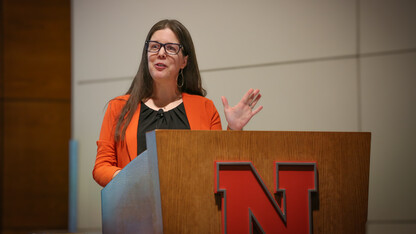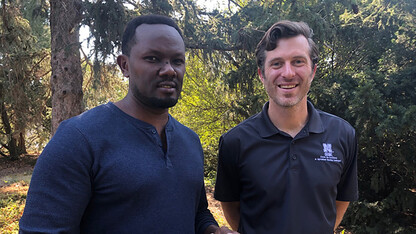
A $1.6 million grant from the National Institutes of Health will help a University of Nebraska-Lincoln chemist investigate how malfunctioning switches in the circuitry of cells contribute to human disease.
Cliff Stains, assistant professor of chemistry, has earned a five-year NIH grant known as the Maximizing Investigators’ Research Award.
“This grant is meant to fund all the research going on in our lab without tying us to specific aims,” Stains said. “It will allow us, in a broad sense, to go where the science takes us.”
Over the past several years, the science has taken Stains into the realm of weak molecular interactions that he has used to develop strategies for probing and even controlling disease-related mechanisms in cells.
Those mechanisms include kinases and phosphatases – enzymes that help activate and deactivate cellular proteins by adding and subtracting phosphate molecules. When working as it should, this phosphate-based balancing act regulates cellular functions ranging from growth to division to migration.
“These kinases and phosphatases can be thought of as the yin and yang of cell signaling,” said Stains. “They act in opposition to one another to control the concentration of phosphorylated protein in a cell. One could think of this entire process as a dimmer switch. In disease states where the catalytic activity of these enzymes is altered, this causes the switch to either be turned on or turned off more than it should.”
To investigate a host of resulting maladies that include cancers, fatty liver disease and Type 2 diabetes, Stains’ lab will use the new NIH grant to fine-tune and apply sensors that can directly measure this enzyme activity.
Shedding some light
By employing a chemical compound that emits fluorescence in the presence of a phosphate molecule, the team’s sensors can literally cast light on the inner workings of a cell. When a kinase ferries a phosphate molecule over to a protein, the sensor glows; when a phosphatase removes the molecule, the sensor dims in response.
This fluorescence signal, which Stains called “straightforward to detect,” allows the lab’s sensors to report more accurate readings than those that have historically relied on indirect measures of enzyme activity.
“We would like to use these in a discovery mode to directly profile the activity of these enzymes in different disease states,” Stains said. “It’s difficult to get at that with indirect proxies, because you’re not really measuring activity – you’re measuring particular modifications on these enzymes, and you don’t really know what they all are. We would instead like to use the technology to get directly at the question that people have been asking for a while: ‘What are the activity differences of these things?’”
The approach is already enabling Stains’ lab to gather data on phosphatase and kinase disruptions that underlie obesity-related fatty liver disease. Going forward, Stains said, the team will use the sensors to explore how enzyme activity may change as fatty liver disease progresses into liver carcinoma, a form of cancer.
Putting the pieces together
Alongside a cadre of graduate students, Stains is also employing a technique that can split a protein’s three-dimensional structure at strategic sites. By attaching additional protein sequences that interact when exposed to various stimuli, the team has demonstrated the ability to reassemble those protein fragments. This essentially gives Stains’ lab the ability to activate and deactivate the proteins at will, representing an important step toward programming a cell.
Stains will first use the technique to achieve control over signaling proteins responsible for cell division and migration. The latter takes the form of metastasis in full-blown cancers, representing the cause of death in about 90 percent of fatal cases, he said.
The technique should also help his lab mimic diseased cells for the sake of interrogating individual enzymes to reveal the true culprits.
“Let’s say that we’re profiling a particular disease state and discover changes in the enzymatic activity,” Stains said. “Now the question becomes: Is that causal, or is that just coincidental? It’s a classic issue in the field. What this could allow us to do is go back into a normal cell and start to re-tune these pathways to what we see in a disease state.
“Does the cell now take on the phenotype of the disease, or did that enzyme just happen to be perturbed because something else upstream went awry, and that enzyme wasn’t actually the root cause? This will help us hunt for drug targets.”
And given that he’s also continuing his research into misfolded proteins, Stains said he’s grateful for the unprecedented flexibility that the new NIH award will provide his lab.
“One of the major ideas of this grant mechanism is to make funding more stable,” he said. “This gives you the freedom to tackle challenging problems.”
Stains received the award from the National Institute of General Medical Sciences under grant number R35 GM119751.








